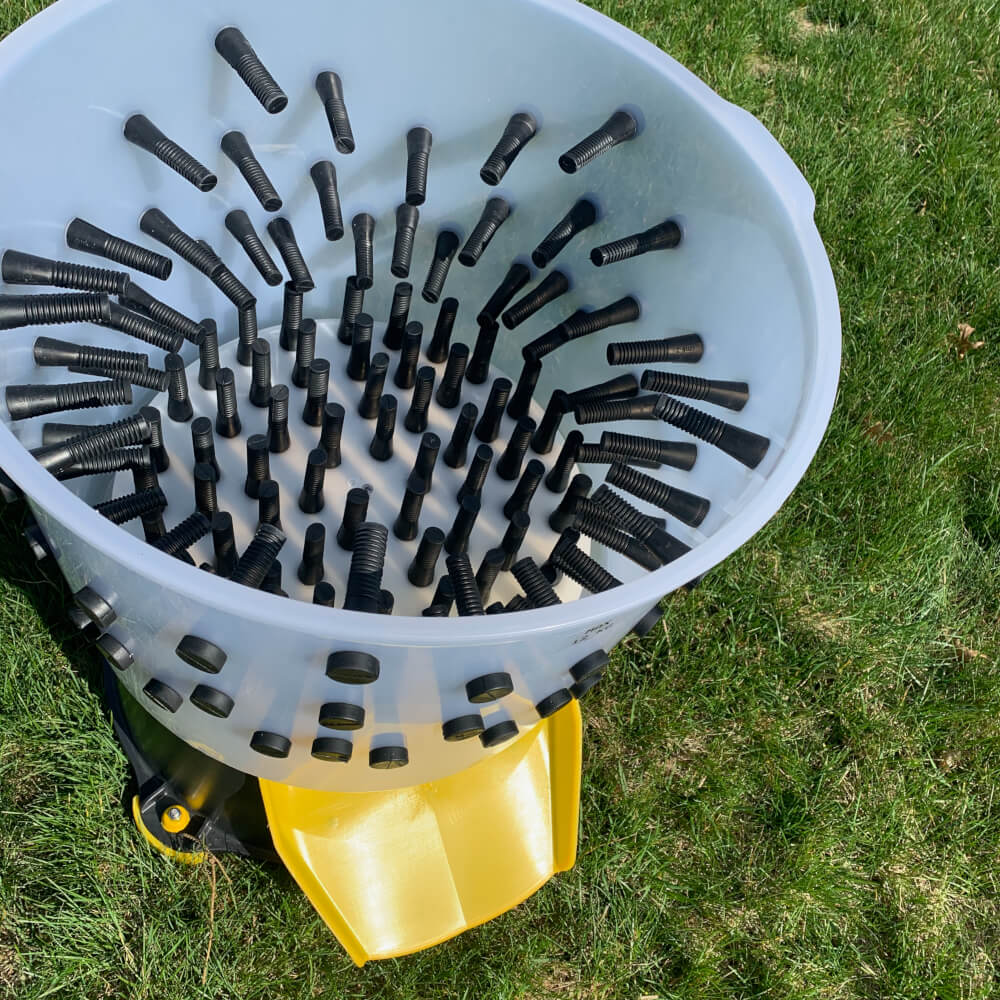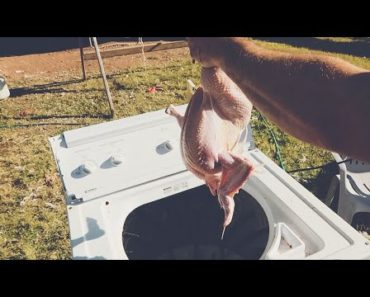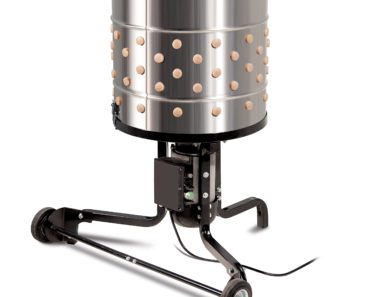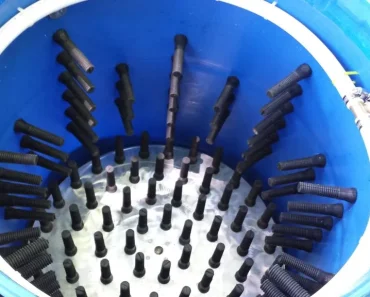Contents
- 1 The Ultimate Guide to Manual Chicken Plucker: Mastering the Art of Efficient Poultry Processing
- 2 How to Butcher a Chicken for Beginners [GRAPHIC]
- 3 The Importance of a Manual Chicken Plucker
- 4 Tips for Using a Manual Chicken Plucker Effectively
- 5 Maintenance and Care Tips for a Manual Chicken Plucker
- 6 FAQ


Discover the Benefits and How-To of Using a Manual Chicken Plucker – Looking for an efficient and cost-effective way to pluck chickens? Look no further! Now, we’ll explore the advantages of using a manual chicken plucker and provide step-by-step instructions on how to use it properly. Get ready for hassle-free plucking!
The Ultimate Guide to Manual Chicken Plucker: Mastering the Art of Efficient Poultry Processing
The Ultimate Guide to Manual Chicken Plucker: Mastering the Art of Efficient Poultry Processing.
Welcome to The Ultimate Guide to Manual Chicken Plucker! In this comprehensive guide, we will delve into the world of efficient poultry processing and explore the art of using a manual chicken plucker. Whether you are a seasoned farmer or a backyard enthusiast, this guide will equip you with the knowledge and skills needed to maximize your chicken plucking efficiency.
Chapter 1: Understanding Manual Chicken Pluckers
In this chapter, we will provide an in-depth understanding of manual chicken pluckers. We will discuss the different parts of a chicken plucker machine, its functions, and how it operates. By the end of this chapter, you will have a solid foundation on which to build your poultry processing skills.
Chapter 2: Proper Setup and Maintenance
One of the keys to efficient chicken plucking is proper setup and regular maintenance of your equipment. In this chapter, we will walk you through the step-by-step process of setting up your manual chicken plucker, ensuring that it is in optimal working condition. We will also discuss best practices for cleaning, lubricating, and troubleshooting common issues.
Chapter 3: The Plucking Technique
Now that you have a well-maintained chicken plucker, it’s time to master the art of the plucking technique. This chapter will guide you through the proper way to hold and position the chicken, the optimal plucking motion, and how to efficiently remove feathers from different parts of the bird. With practice, you’ll become a pro at plucking chickens in no time.
Chapter 4: Maximizing Efficiency
Efficiency is crucial when it comes to poultry processing. In this chapter, we will share tips and tricks to help you maximize your chicken plucking efficiency. From organizing your work area to using time-saving techniques, you’ll discover how to process chickens faster without compromising quality.
Chapter 5: Troubleshooting and Maintenance Tips
Even with proper setup and maintenance, occasional issues may arise with your manual chicken plucker. This chapter will provide troubleshooting tips for common problems and offer maintenance advice to keep your machine running smoothly in the long run.
Chapter 6: Safety Precautions
Safety should always be a top priority when handling poultry processing equipment. In this final chapter, we will emphasize the importance of safety precautions when using a manual chicken plucker. From wearing protective gear to following proper hygiene practices, we will help you create a safe environment for yourself and your birds.
The Ultimate Guide to Manual Chicken Plucker is your go-to resource for mastering the art of efficient poultry processing. Whether you are a beginner or an experienced user, this guide will provide valuable insights and practical tips for enhancing your chicken plucking skills. Get ready to become a chicken plucking expert!
How to Butcher a Chicken for Beginners [GRAPHIC]
The Importance of a Manual Chicken Plucker
Having a reliable and efficient manual chicken plucker is crucial for poultry farmers and processors. In this section, we will explore why a manual chicken plucker plays a vital role in poultry processing and the various benefits it offers.
A manual chicken plucker is designed to remove feathers from chickens quickly and effectively, saving time and effort compared to traditional plucking methods. With strong and durable rubber fingers, it efficiently removes feathers without damaging the skin or leaving any residue behind.
Furthermore, a manual chicken plucker allows for precise control, ensuring that all feathers are removed from hard-to-reach areas such as wings and necks. This results in a cleaner and more presentable final product, which is essential for maintaining high standards of hygiene and quality.
In addition, manual chicken pluckers are often portable and easy to operate, making them suitable for small-scale poultry operations or on-farm processing. They do not require a power source, making them cost-effective and environmentally friendly.
Overall, investing in a manual chicken plucker is a wise choice for poultry farmers and processors, as it offers efficiency, precision, and convenience while maintaining quality and hygiene standards.
Tips for Using a Manual Chicken Plucker Effectively
Using a manual chicken plucker correctly is essential to achieve optimal results. In this section, we will provide some useful tips on how to use a manual chicken plucker effectively.
– Prepare the chickens: Before using the plucker, make sure the chickens have been properly scalded. Scalding helps loosen the feathers, making plucking easier and faster.
– Position the chickens: Place the chickens in the plucker one at a time, ensuring that they are properly positioned to maximize plucking efficiency. Adjust the rubber fingers if necessary to ensure optimal contact with the feathers.
– Maintain cleanliness: Regularly clean the plucker during and after use to prevent a buildup of feathers and debris. This will help maintain its performance and extend its lifespan.
– Follow safety precautions: Always wear protective gloves and goggles when operating the manual chicken plucker. Be cautious of moving parts and ensure that the plucker is securely placed on a stable surface before use.
– Practice and adjust: It may take some practice to master the technique of using a manual chicken plucker effectively. Adjust the speed and pressure applied to the chickens based on your experience and the type of feathers being removed.
Maintenance and Care Tips for a Manual Chicken Plucker
To ensure a long lifespan and optimal performance of your manual chicken plucker, regular maintenance and care are crucial. In this section, we will provide some tips on how to properly maintain and care for your manual chicken plucker.
– Clean and sanitize: After each use, thoroughly clean and sanitize the plucker to remove any feathers, debris, or bacteria. Use mild detergent and warm water to clean all parts, ensuring that they are completely dry before storage.
– Inspect for damages: Regularly inspect the rubber fingers, motor, and other components for any signs of wear or damage. Replace any worn-out or damaged parts promptly to avoid compromising the plucker’s performance.
– Lubricate moving parts: Apply lubricant to the moving parts as recommended by the manufacturer. This helps reduce friction and ensures smooth operation.
– Store properly: Store the manual chicken plucker in a clean and dry area, away from direct sunlight and moisture. Remove any excess feathers or debris before storing to prevent odors or potential damage.
– Follow manufacturer’s instructions: Always refer to the manufacturer’s instructions and recommendations for specific maintenance and care guidelines. These guidelines may vary depending on the make and model of the manual chicken plucker.
FAQ
What are the top tips for effectively using a manual chicken plucker?
When using a manual chicken plucker, there are several tips to keep in mind for effective use:
1. **Preparation is key**: Before starting, make sure the chickens have been properly slaughtered and scalded to loosen the feathers. This will make the plucking process easier and more efficient.
2. **Secure the plucker**: Ensure that the plucker is properly locked or mounted to a stable surface to prevent it from moving or tipping over during operation. This will provide a safer working environment.
3. **Keep the plucker clean**: Periodically clean the plucker’s rubber fingers to remove any feathers, dirt, or debris. This will help maintain optimal plucking performance.
4. **Maintain a steady pace**: Pluck one chicken at a time and maintain a consistent rhythm. Rushing the process may result in incomplete feather removal or damage to the bird’s skin.
5. **Pay attention to feather direction**: Pluck the feathers against their natural direction of growth. This will make the process more efficient and ensure better results.
6. **Rotate the bird**: As you pluck, rotate the bird in a circular motion to access all areas evenly. This will help remove feathers from hard-to-reach spots.
7. **Inspect and touch up**: After plucking, carefully inspect the bird for any remaining feathers. Use tweezers or pliers to remove any stubborn ones that were missed.
8. **Clean and sanitize**: Once you’re finished plucking, thoroughly clean and sanitize the plucker and any other equipment used to maintain hygiene standards.
Following these tips will result in a more efficient and effective manual chicken plucking process, allowing you to achieve better results and save time.
How can I properly clean and maintain a manual chicken plucker to ensure optimal performance?
To properly clean and maintain a manual chicken plucker for optimal performance, follow these steps:
1. **Shut off and unplug**: Before cleaning the chicken plucker, make sure it is turned off and unplugged from any power source to avoid any accidents.
2. **Remove feathers and debris**: Start by removing any feathers or debris that may have accumulated in the plucker. Use a brush or a cloth to wipe away any loose feathers or particles.
3. **Disassemble the plucker**: If possible, disassemble the plucker according to the manufacturer’s instructions. This will allow you to clean each component thoroughly.
4. **Clean the drum**: The drum is the most crucial part of the plucker, as it removes feathers from the chicken. Use warm soapy water and a scrub brush to clean the drum, paying extra attention to any hard-to-reach areas. Rinse it thoroughly with clean water afterwards.
5. **Clean the fingers**: The fingers, also known as plucker fingers or rubber fingers, are the small protruding parts inside the drum that help remove the feathers. Remove the fingers and clean them individually using warm soapy water. Ensure all dirt, feathers, and residue are removed. Rinse them thoroughly before reattaching.
6. **Clean other components**: Clean any other removable components of the plucker, such as the base, motor, or wheels, using warm soapy water or a mild cleaning solution. Be cautious not to submerge any electrical parts in water. Wipe them dry after cleaning.
7. **Inspect for damage**: While cleaning, inspect the plucker for any signs of damage or wear and tear. Check for loose screws, cracks, or any other issues that may affect its performance. Replace or repair any damaged parts as necessary.
8. **Lubricate moving parts**: Apply a food-grade lubricant to the moving parts of the plucker, such as the bearings or gears, to ensure smooth operation. Refer to the manufacturer’s instructions for recommended lubricants.
9. **Reassemble and test**: Reassemble the plucker, ensuring all components are properly attached. Plug it back in and turn it on to check if it is working smoothly. Make any necessary adjustments or repairs before using it again.
10. **Regular maintenance**: Establish a regular maintenance schedule for your chicken plucker. This may include cleaning after each use, lubricating moving parts periodically, and performing thorough inspections to ensure optimal performance and longevity of the equipment.
Remember to always refer to the manufacturer’s instructions for specific cleaning and maintenance recommendations for your chicken plucker model.
Are there any safety precautions or guidelines to follow when operating a manual chicken plucker?
When operating a manual chicken plucker, it is important to follow certain safety precautions and guidelines.
1. Read the instructions: Familiarize yourself with the user manual provided by the manufacturer before operating the chicken plucker. Ensure you understand all the instructions for safe operation.
2. Wear protective gear: Always wear appropriate personal protective equipment (PPE) such as gloves, goggles, and aprons to protect yourself from any potential injuries or contamination.
3. Secure the plucker: Make sure the chicken plucker is securely placed on a stable surface to prevent any accidents or injuries. Avoid placing it on uneven or slippery surfaces.
4. Inspect the plucker: Before using the machine, inspect it thoroughly for any signs of damage or malfunction. Check for loose parts, frayed wires, or any other potential hazards. Do not use a faulty chicken plucker.
5. Keep hands clear: Keep your hands and fingers away from moving parts while the machine is in operation. Avoid reaching into the plucker while it is running to prevent injuries.
6. Use proper technique: Follow the recommended technique of placing the chickens one at a time into the plucker to ensure a smooth and effective process. Do not overload the machine or force the chickens into the plucker.
7. Maintain cleanliness: Prioritize hygiene by regularly cleaning and sanitizing the chicken plucker after each use. Remove any feathers, dirt, or debris from the machine to prevent contamination.
8. Disconnect power: After use, always unplug the chicken plucker from the power source and make sure it is turned off before performing any maintenance or cleaning tasks.
Remember, these are general safety guidelines, and it is essential to follow the specific instructions provided by the manufacturer of your chicken plucker for safe and proper operation.
The manual chicken plucker is an indispensable tool for poultry farmers and enthusiasts alike. With its durable construction and efficient plucking capabilities, it offers a reliable and cost-effective solution for processing chickens. The easy-to-use design ensures that even those with limited experience can effectively remove feathers without damaging the skin. Furthermore, its portable nature allows for flexibility in various settings, making it suitable for both small-scale and commercial operations. Whether you’re raising chickens for personal consumption or running a profitable business, investing in a manual chicken plucker will undoubtedly streamline your feather removal process and boost productivity. So don’t hesitate to explore the options available and find the perfect chicken plucker for your needs!



